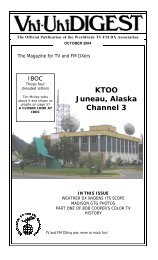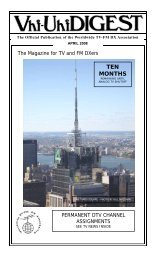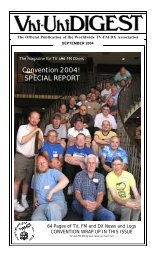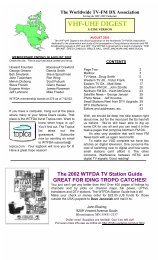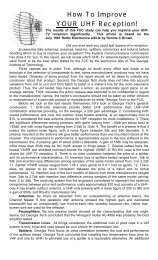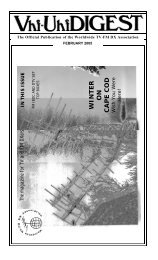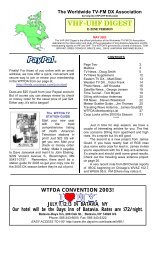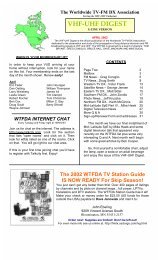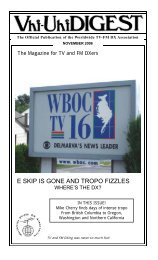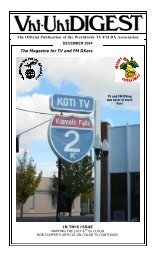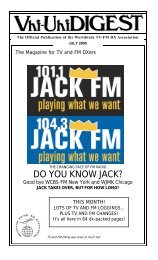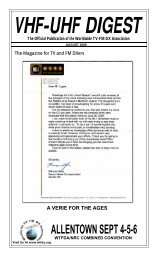MAY - WTFDA.org
MAY - WTFDA.org
MAY - WTFDA.org
Create successful ePaper yourself
Turn your PDF publications into a flip-book with our unique Google optimized e-Paper software.
Antennas:<br />
Marketing suggests you need a special antenna to receive digital signals. I have<br />
a “Stereo compatible color antenna” box in my basement. “Antenna” is the only word<br />
that's meaningful!<br />
Stereo, color, and now digital TV signals are all broadcast in the same frequency<br />
range. What makes an antenna good for analog reception is the same thing that makes<br />
it good for digital. Accessories – preamps, splitters, coaxial cable, rotors, switches, etc.<br />
- are all the same for digital as they are for analog. If you have a good DX antenna<br />
system in place for analog, you can simply connect it to your DTV receiver and have a<br />
good DTV DX system. If you don't already have a good analog antenna system, just<br />
remember that the same rules that apply to analog apply to DTV.<br />
There is one important difference. Digital TV is very intolerant of multipath -<br />
“ghosts”. You may be able to tolerate watching an analog signal with a single stationary<br />
ghost, but your DTV receiver may not decode such a digital signal at all. Any poor<br />
cable connections, cheap cable, leaky splitters, or sources of signal reflections will need<br />
to be fixed or replaced before you'll get reliable digital reception.<br />
Propagation modes:<br />
To date, virtually all DTV DX has been via tropospheric propagation. The current<br />
tropospheric distance record is 835 miles. 4 Tropospheric propagation affects all<br />
channels including UHF, and tends to be stable in signal strength over moderate<br />
periods. This allows the DTV receiver enough time to “lock in” on a signal. UHF<br />
channels have fewer stations 5 , so there's less interference to prevent DTV “lock”.<br />
One DTV signal has been identified via sporadic-E. 6 Sporadic-E tends to involve<br />
deep and rapid fading; often, an Es DTV signal doesn't stay in long enough to decode.<br />
Es also only affects VHF channels, where there are many more analog stations. The<br />
chances of interference from other stations are much greater. Finally, there are very<br />
few digital stations currently operating on VHF channels 2-6. 7<br />
Luckily, the latter issue will eventually change. 35 stations have digital<br />
assignments “outside core”, in channels 52-69, while having analog assignments in<br />
channels 2-6. These stations (at least in theory!) will be required to move their digital<br />
operations to their low-band channels at the end of transition. Many of the mostfrequently-seen<br />
analog Es stations are among this list – WMAR-2, WCAX-3, KGFE-2,<br />
WOAI-4, KTVU-2, KQTV-2, WEDU-3, KJRH-2.<br />
4For reception of WNCN-DT channel 55 Goldsboro, North Carolina by DXer Jeff Kruszka in Baton Rouge,<br />
Louisiana.<br />
5There are 62 full-power analog stations in the USA on channel 7; there are only 15 such stations on channel 47.<br />
6Gerard Westerberg in Lexington, Kentucky received KOTA-DT channel 2 Rapid City, South Dakota. Only PSIP<br />
data was decoded – no usable audio or video.<br />
7As of August 2003 I'm only aware of eight low-band VHF DTV stations.<br />
18



